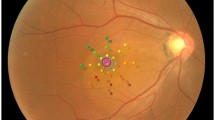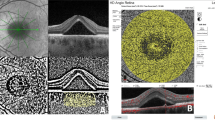Abstract
Purpose
To investigate fixation pattern and retinal sensitivity in patients with serpiginous choroiditis (SC).
Methods
Twenty-eight eyes (14 patients) with SC were evaluated. Best-corrected visual acuity, color fundus photography, fundus autofluorescence, and fluorescein and indocyanine green angiography were performed. Microperimetry was used to assess fixation pattern and retinal sensitivity.
Results
Of 28 eyes, 16 (57%) had central, one (4%) poor central, and 11 (39%) eccentric fixation; and 18 (64%) had stable, four (14%) relatively unstable, and six (21%) unstable fixation. In patients with posterior pole symmetrically involved in both eyes, the better eye had stable and central fixation in all cases. Atrophic lesions were characterized by a dense scotoma in all cases, with a relative scotoma at their margins in ten eyes (38%). In two cases of active disease, a dense scotoma correlated to an active lesion could be detected. A relative scotoma was documented in areas not involved by the disease at the posterior pole in eight eyes (28%), and in the peripapillary area in 11 eyes (39%).
Conclusions
Quantification of retinal sensitivity and fixation pattern by microperimetry offers new data about the impact of visual impairment in patients with SC. A reduction of retinal sensitivity in an apparently healthy area suggests a wider functional involvement of the retina, undetectable by morphologic evaluation alone.






Similar content being viewed by others
References
Chisholm IH, Gass JDM, Hutton WL (1976) The late stage of serpiginous (geographic) choroiditis. Am J Ophthalmol 82:343–351
Lim W, Buggage RR, Nussemblatt RB (2005) Serpiginous choroiditis. Surv Ophthalmol 50:231–244
Weiss H, Annesley WH Jr, Shields JA, Tomer T (1979) The clinical course of serpiginous choroidopathy. Am J Ophthalmol 87:133–142
Christmas NJ, Oh KT, Oh DM, Folk JC (2002) Long-term follow-up of patients with serpiginous choroiditis. Retina 22:550–556
Laatikainen L, Erkkilä H (1982) Subretinal and disc neovascularisation in perpiginous choroiditis. Br J Ophthalmol 66:326–331
Owsley C, Slogane M (1987) Contrast sensitivity, visual acuity and the perception of “real word” targets. Br J Ophthalmol 71:791–796
Midena E, Radin PP, Convento E (2007) Liquid crystal display microperimetry. In: Midena E (ed) Perimetry and the fundus: an introduction to microperimetry. Slack Inc., Thorofare, NJ, pp 16–25
Midena E, Radin PP, Pilotto E, Ghirlando A, Convento E, Varano M (2004) Fixation pattern and macular sensitivity in eyes with subfoveal choroidal neovascularization secondary to age-related macular degeneration. A microperimetry study. Semin Ophtalmol 19:55–61
Fletcher DC, Schuchard RA (1997) Preferred retinal loci relationship to macular scotomas in a low vision population. Ophthalmology 104:632–638
Doris N, Hart PM, Chakravarthy U, McCleland J, Stevenson M, Hudson C, Jackson J (2001) Relation between macular morphology and visual function in patients with choroidal neovascularization of age related macular degeneration. Br J Ophthalmol 85:184–188
Ferris FL 3rd, Kassoff A, Bresnick GH, Bailey I (1982) New visual acuity charts for clinical research. Am J Ophthalmol 94:91–96
Vujosevic S, Midena E, Pilotto E, Radin PP, Chiesa L, Cavarzeran F (2006) Diabetic macular edema: correlation between microperimetry and optical coherence tomography findings. Invest Ophthalmol Vis Sci 47:3044–3051
Fujii GY, De Juan Jr E, Sunness J, Humayun MS, Pieramici DJ, Chang TS (2002) Patient selection for macular translocation surgery using the scanning laser ophthalmoscope. Ophthalmology 109:1737–1744
Midena E, Vujosevic S, Convento E, Manfre A, Cavarzeran F, Pilotto E (2007) Microperimetry and fundus autofluorescence in patients with early age-related macular degeneration. Br Journal Ophthalmol 91(11):1499–503
Sunness JS, Gonzalez-Baron J, Applegate CA, Bressler NM, Tian Y, Hawkins B, Barron Y, Bergman A (1999) Enlargement of atrophy and visual acuity loss in the geographic atrophy form of age-related macular degeneration. Ophthalmology 106:1768–1779
Sunness JS, Bressler NM, Maguire MC (1995) Scanning laser ophthalmoscopic analysis of the pattern of visual loss in age-related geographic atrophy of the macula. Am J Ophthalmol 119:143–151
Sunness JS, Applegate CA, Gonzalez-Baron J (2000) Improvement of visual acuity over time in patients with bilateral geographic atrophy from age-related macular degeneration. Retina 20:162–169
Cardillo Piccolino F, Grosso A, Savini E (2009) Fundus autofluorescence in serpiginous choroiditis. Graefes Arch Clin Exp Ophthalmol 247:179–185
Giovannini A, Mariotti C, Ripa E, Scassellati-Sforzolini B (1996) Indocyanine green angiography findings in serpiginous choroidopathy. Br J Ophthalmol 80:536–540
Caspers L (2009) Serpiginous choroiditis. In: Gupta A, Gupta V, Herbort CP, Khairallah M (eds) Uveitis text and imaging. Jaypee Brothers Medical Publishers (P) Ltd, New Delhi, pp 468–478
Secchi AG, Tognon MS, Maselli C (1990) Cyclosporin-A in the treatment of serpiginous choroiditis. Int Ophthalmol 14:395–399
Ohno-Matsui K, Horie S, Mochizuki M (2009) Vogt-Koyanagi-Harada (VKH) disease. In: Gupta A, Gupta V, Herbort CP, Khairallah M (eds) Uveitis text and imaging. Jaypee Brothers Medical Publishers (P) Ltd, New Delhi, pp 529–540
Author information
Authors and Affiliations
Corresponding author
Additional information
The Authors have no financial interest in any of the instruments reported in this paper.
The authors have full control of all primary data, and they agree to allow Graefe's Archive for Clinical and Experimental Ophthalmology to review their data upon request.
Rights and permissions
About this article
Cite this article
Pilotto, E., Vujosevic, S., Grgic, V.A. et al. Retinal function in patients with serpiginous choroiditis: a microperimetry study. Graefes Arch Clin Exp Ophthalmol 248, 1331–1337 (2010). https://doi.org/10.1007/s00417-010-1405-y
Received:
Revised:
Accepted:
Published:
Issue Date:
DOI: https://doi.org/10.1007/s00417-010-1405-y




